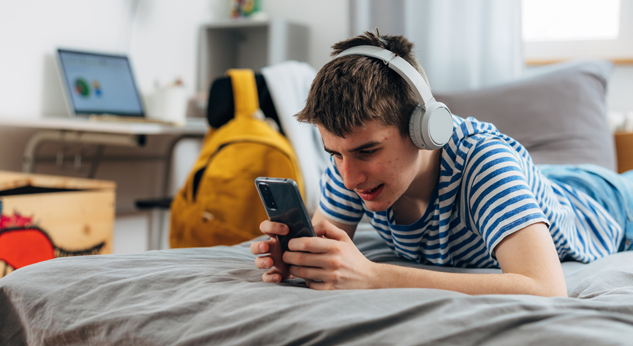
Power in a Beat: Transform School Counseling With Music
By Damien Sweeney, Ed.D. | May 2025

We’ve all been there – ready to start a small group, excited, only to be met with slouched shoulders and averted eyes. You may have even Googled or used ChatGPT for icebreakers, which sometimes succeed and other times get an eye roll. Instead of hoping for engagement, why not use music? Music is a universal language. Even when we don’t understand the lyrics, we can connect with its rhythm and emotion.
Think about students as they get on and off the bus – what do most of them have? Headphones. Music is part of their identity.
This aligns with healing-centered engagement, shifting from asking, “What happened to you?” to “What’s right with you?” This approach views students as active agents in their own well-being rather than victims of trauma. It’s similar to the South African concept of Ubuntu – finding humanness through interdependence and collective engagement.
Instead of viewing students through labels such as “low SES,” school counselors should recognize how resilient they can be, despite challenges. Music can be the tool that brings this resilience to the surface.
And if they don’t like your selection? Stay humble. Once, I used a deep, meaningful song, and a student said, “The lyrics were just okay, and the beat sucked.” Instead of being discouraged, I asked what songs they would suggest. These moments show students you care about their interests and that you are willing to listen to them.
1. “Dear Mama” by 2Pac
2. “Me Against the World” by 2Pac
3. “A Dream” by Jay Z
4. “Love Yourz” by J Cole
5. “Crown” by Chika
6. “All My Life” by Lil Durk, J. Cole
7. “Thursday” by Jess Glynne
8. “Got Character” by Kiff Cast (for elementary aged students)
Contact Damien Sweeney, Ed.D., assistant principal at Westport Middle School in Louisville, Kentucky, at damien.sweeney@jefferson.kyschools.us.
Think about students as they get on and off the bus – what do most of them have? Headphones. Music is part of their identity.
The Power of Hip Hop Counseling
Hip hop counseling takes something students love and uses it to explore emotions in small group settings. It’s also asset based. One cultural shift I’m trying to create at my school is focusing on students’ strengths rather than just correcting behaviors. Instead of “Take that hoodie off,” or “Put that phone away,” we should reinforce positive behaviors and contributions.This aligns with healing-centered engagement, shifting from asking, “What happened to you?” to “What’s right with you?” This approach views students as active agents in their own well-being rather than victims of trauma. It’s similar to the South African concept of Ubuntu – finding humanness through interdependence and collective engagement.
Instead of viewing students through labels such as “low SES,” school counselors should recognize how resilient they can be, despite challenges. Music can be the tool that brings this resilience to the surface.
Where Do I Start?
Start by asking students what music they enjoy. AI can help find inspiring songs, but student input is key. I print out lyrics (editing out profane words) and ask students to annotate what stands out to them, then connect it to their lives.What If I Choose the Wrong Music?
I work in a middle school in Louisville, Kentucky, and I’m often surprised by how many students wear shirts featuring 2Pac, Outkast or Aaliyah (hip hop and R&B artists from the 1990s). You don’t have to know the latest hits; introducing them to music from your own past can be just as effective.And if they don’t like your selection? Stay humble. Once, I used a deep, meaningful song, and a student said, “The lyrics were just okay, and the beat sucked.” Instead of being discouraged, I asked what songs they would suggest. These moments show students you care about their interests and that you are willing to listen to them.
Power in a Beat
We’ve all heard a song with a beat that moves us. Try using instrumental beats from YouTube or AI to inspire students to write their own lyrics – no performance required, just an exercise in expression. Many teachers already play lo-fi hip-hop during work time to create a calm, focused environment.What Does the Research Say?
Emerging research underscores music’s benefits for students. Music education has a significant positive effect on psychological well-being, which in turn improves academic performance. Self-efficacy and self-esteem mediate this relationship, showing that music has a deeper effect than we may realize.Embracing the Leap
Think of two diving boards: one low and one high. The low dive is safe and fun, but the high dive is thrilling – it’s scary, unpredictable, but worth it. Using music in school counseling might feel like the high dive, but the impact will make the leap worthwhile. You’ve got this!Resources
- Using Music to Engage Students, webinar with Dr. Sweeney and music producer Laze Elliott
- Damian Sweeney’s website
- “The Roots Beneath the Rose: Hip-hop, Counselling, and Development,” by I. Levy, T. Hicks Harper, Q. Spellman and C. Emdin, 2021
1. “Dear Mama” by 2Pac
2. “Me Against the World” by 2Pac
3. “A Dream” by Jay Z
4. “Love Yourz” by J Cole
5. “Crown” by Chika
6. “All My Life” by Lil Durk, J. Cole
7. “Thursday” by Jess Glynne
8. “Got Character” by Kiff Cast (for elementary aged students)
Contact Damien Sweeney, Ed.D., assistant principal at Westport Middle School in Louisville, Kentucky, at damien.sweeney@jefferson.kyschools.us.